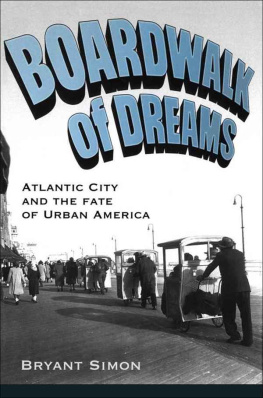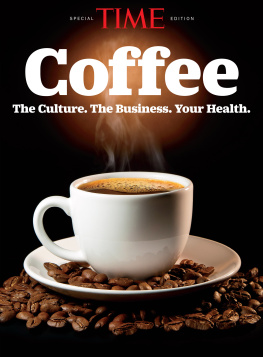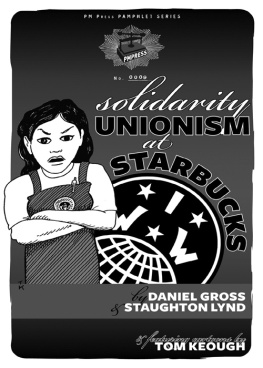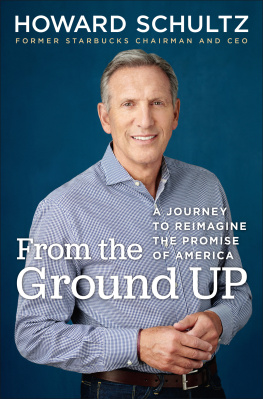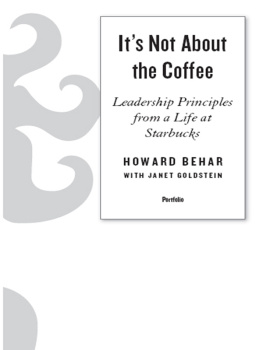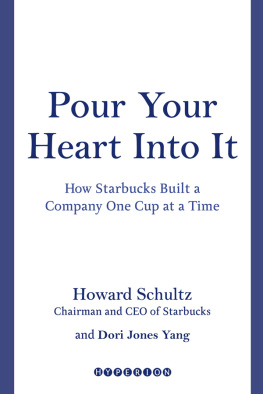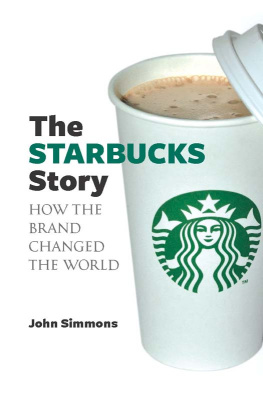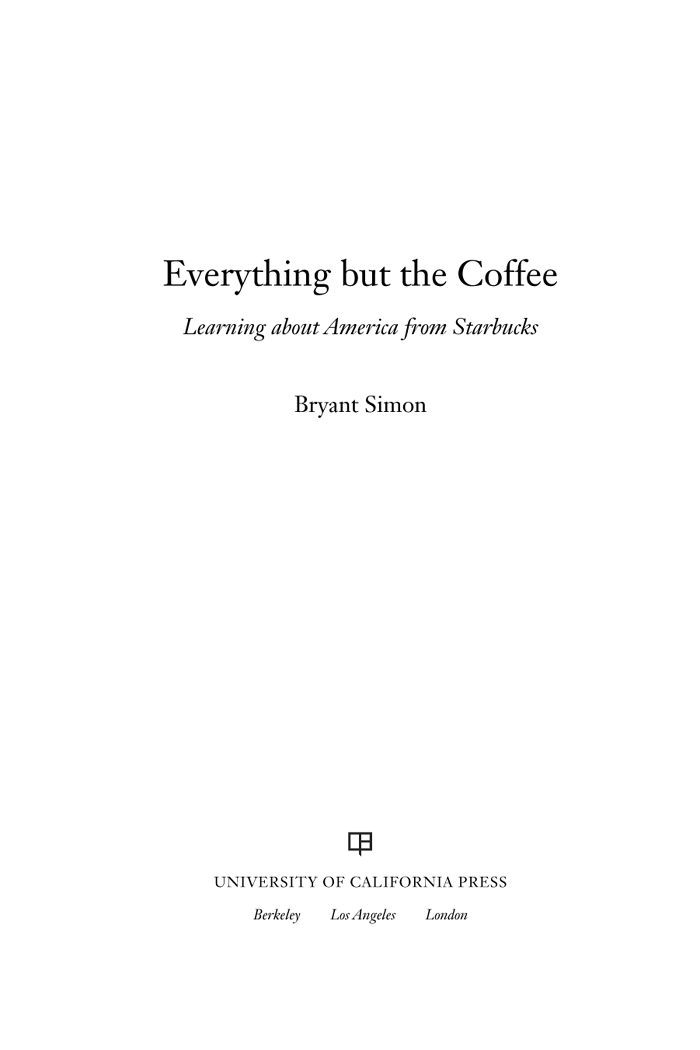Everything but the Coffee
Everything but the Coffee
Learning about America from Starbucks
Bryant Simon

University of California Press, one of the most distinguished university presses in the United States, enriches lives around the world by advancing scholarship in the humanities, social sciences, and natural sciences. Its activities are supported by the UC Press Foundation and by philanthropic contributions from individuals and institutions. For more information, visit www.ucpress.edu.
University of California Press
Berkeley and Los Angeles, California
University of California Press, Ltd.
London, England
2009 by Bryant Simon
Library of Congress Cataloging-in-Publication Data
Simon, Bryant.
Everything but the coffee : learning about America from Starbucks / Bryant Simon.
p. cm.
Includes bibliographical references and index.
ISBN 978-0-520-26106-8 (cloth : alk. paper)
1. CoffeeUnited States. 2. CoffeehousesUnited States. 3. Starbucks Coffee Company.
I. Title.
TX415.S523 2009
641.3'373dc22 2009006142
Manufactured in the United States of America
18 17 16 15 14 13 12 11 10 09
10 9 8 7 6 5 4 3 2 1
This book is printed on Cascades Enviro 100, a 100% post consumer waste, recycled, de-inked fiber. FSC recycled certified and processed chlorine free. It is acid free, Ecologo certified, and manufactured by BioGas energy.
To my friends
Libby McRae and Bill Deverell
CONTENTS
ACKNOWLEDGMENTS
I just keep finding myself with debts no honest man can pay. Luckily, no one seems to want to collect, but they deserve some acknowledgment, even though they would never ask. This wasnt an easy book to write. A lot of the time I felt like I was chasing a moving target. Just when I had it in my sights, it was gone. I couldnt have kept up this frustrating search without the help, kindness, advice, indulgence, patience, warmth, grace, and warm cups of coffee from friends, colleagues, neighbors, and family.
Just about everyone I know helped out on this book in some way. They listened to my Starbucks stories and told me their Starbucks stories. And lots of people I didnt know took time to hang out at Starbucks with me or to write me an e-mail or talk to me over the phone about what they saw and what they knew about the company and its products. Their insights fill every page of this book. A fewlike John Moore, Michelle Isroff, Greg Beck, Dave Norton, Symbol Lai, and Laura Paquet (who met with me on her anniversary)deserve an extra shout-out. Tom Sugrue, Josh Cole, Steve Kantrowitz, Sharon Zukin, David Grazian, Beth Hale, Marisa Chapell, Keith Brown, Barry Altman, Beth Bailey, David Farber, Jane Dailey, Glenda Gilmore, Heather Thompson, Moshe Sluhovsky, Sarah Igo, Susan Herbst, Elizabeth Royte, Paul Sutter, Beau Weston, Jonathan Morris, Bing Broderick, Michael Goldberg, Andy Lewis, Kathy Walsh, Craig Thompson, Lily Geismer, Malcolm Murfett, Ian Gordon, Michael Goldberg, Margo Borten, Mark Huddle, Charles Fishman, Peter Coclanis, Robert Devens, Cathy Staples, Anne Marshall, and Jimmy Giesen recommended books and articles and read and commented on chapters, sections, paragraphs, sentences, and fragments of this book. Diego Del Pozo and Jose Alvarez went with me on far-flung research trips and helped me to make sense of what I was hearing. Naomi Schneider at the University of California Press guided this book through its final stages, while Geri Thoma stayed with the project from start to end, and even in the rocky middle.
I needed all of this advice and encouragement. But I also needed the trust and faith of good friends like Stephanie McCurry, who never pretended things werent bad when they were bad. And like Libby McRae, who cant be matched for her perfect pitch and loyalty. And like Bill Deverell, who I knew I could always, and then always again, count on. And like a new friend, Matt Wray, who helped me to see what I had and how to talk about it. And like Joe Lorenc, Jeanne Sokolak, Jon Ellens best friend, Jeffrey Lutzner, Jessica DeGroot, John Shanley, Rachel Shanley, and all of their kids, whom my kids call their cousins, because, as my kids say, they really are.
Never, not while writing this book or ever, did I need a light to get home. My family has never wavered in their support and their love. Not my brother and his family, Bradley, Sharon, Rebecca, and Max. Not my in-laws, Tom and Maria Reardon and Christina and Tom Grimes. And not my mom and dad, Bob and Susan Simon. It is hard to explain, and even harder to understand, just how true and steadfast they are in their love.
For me, this book had a soundtrack, the music that played in my head and out of my computer as I wrote. It was Springsteen, Marah, Miles Davis, the Smiths (that was the difficult middle part), and the late, great Snooks Eaglin, but mostly it was the Drive-By Truckers. To me, they make rock-and-roll sound the way it should soundsad, hopeful, triumphant, unrepentant, and loud. In a slower song that came out during the last year that I was working on this book, one of Patterson Hoods not-so-simple characters wonders about heaven and whether you take the vengeance of this world with you there. But then he thinks for a moment that maybe heaven is Saturday morning with his two daughters and his beautiful wife. Im not sure about heaven, Mr. Patterson Hood, but I think I know what you mean. My two sweet, sweet boys and Ann Marie have given methrough all the drafts and false starts of this bookthat quietly radiant, perfect gift of Saturday morningthat time when nothing spectacular is going on other than the play-by-play of an imaginary basketball game, the rustling of the newspaper, the groaning of the coffee pot, and the spinning of the dryer. Even more than the Truckers insistent rhythms and layers of guitars, it was this music, the warm tunes of Saturday morning, that pulled me through the cuts, rewrites, and missteps of this book. These songs are the answers to my prayers, my reason to believe, my faith. I live for Saturday morning and my two beautiful, funny, creative boys, Eli and Benjamin, and my kind, generous, smart, and, yes, beautiful wife, Ann Marie. Thanks so much to them for that gift, a gift I dont mind chasing after, catching, and wrapping my arms around every day.
Introducing the Starbucks Moment
In January 2009, as the United States waited for a new president to take office and tried to make sense of the most severe economic downturn since the Great Depression, Esquire published a short interview with Alice Cooper. It used to be said: As GM goes, so goes America, declared the early shock-rocker and voice behind the anthem Schools Out. Now its: As Starbucks goes, so goes America. Leave it to some-one from the cultural realm to detect this larger transformation in the American economy. During GMs reign as the nations financial bell-wether, business in the United States revolved around production, employment, and consumptionmaking things, creating good jobs, and selling big-ticket items. While Starbucks would never matter as much as GMit never generated as much income, employed as many people, or sustained as many related industriesit was equally emblematic. During the days that the nation moved in tandem with Starbucks and latte sales, the American economy turned almost entirely on buying alone, not the trio of production, jobs, and purchasing. Through this epoch, buying drove the nations economic engine, and even more, it shaped the daily lives, identities, and emotions of the countrys citizenry.



